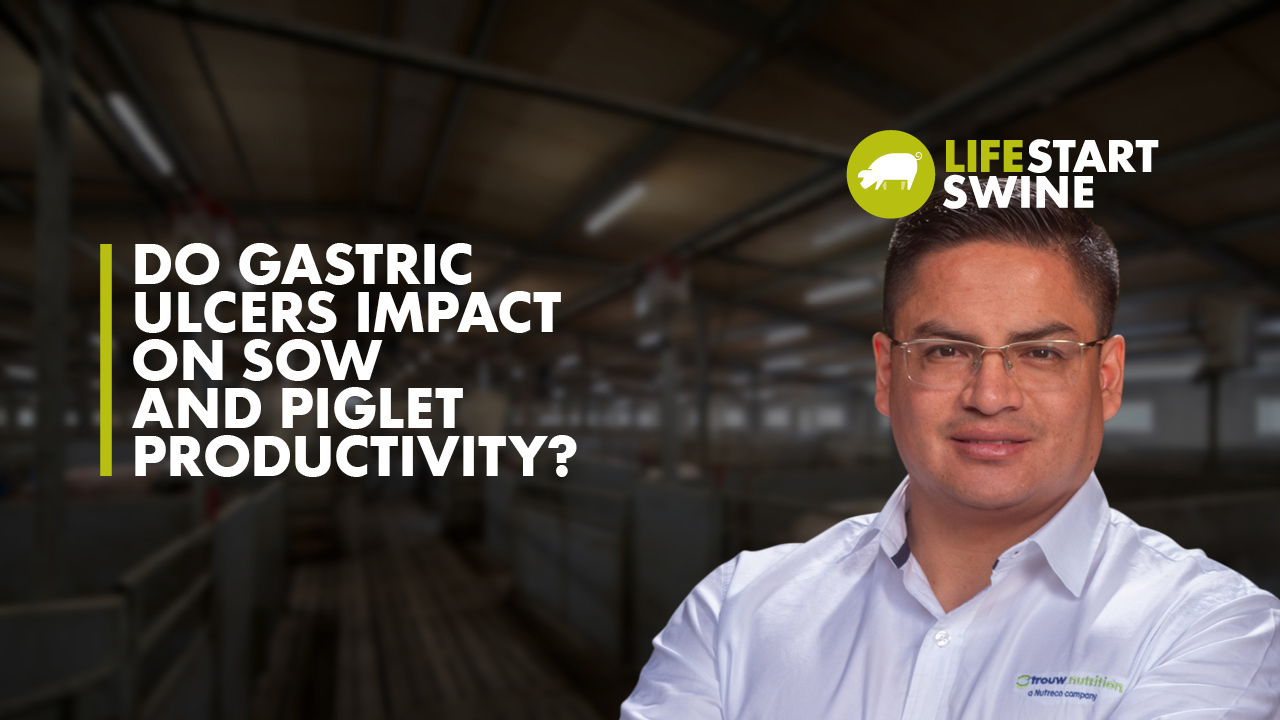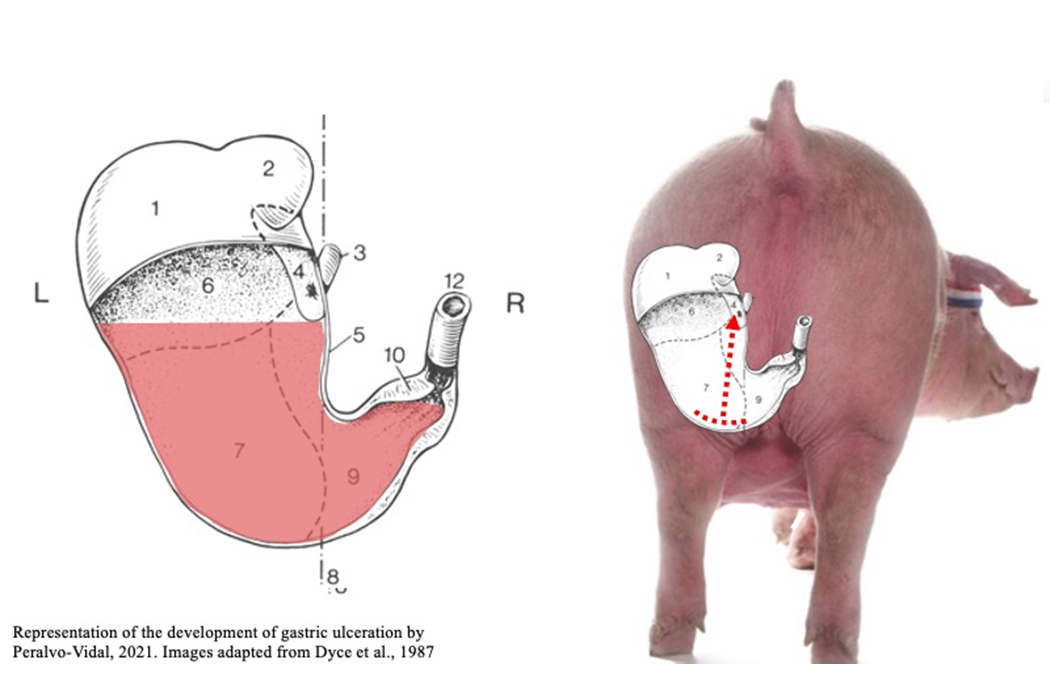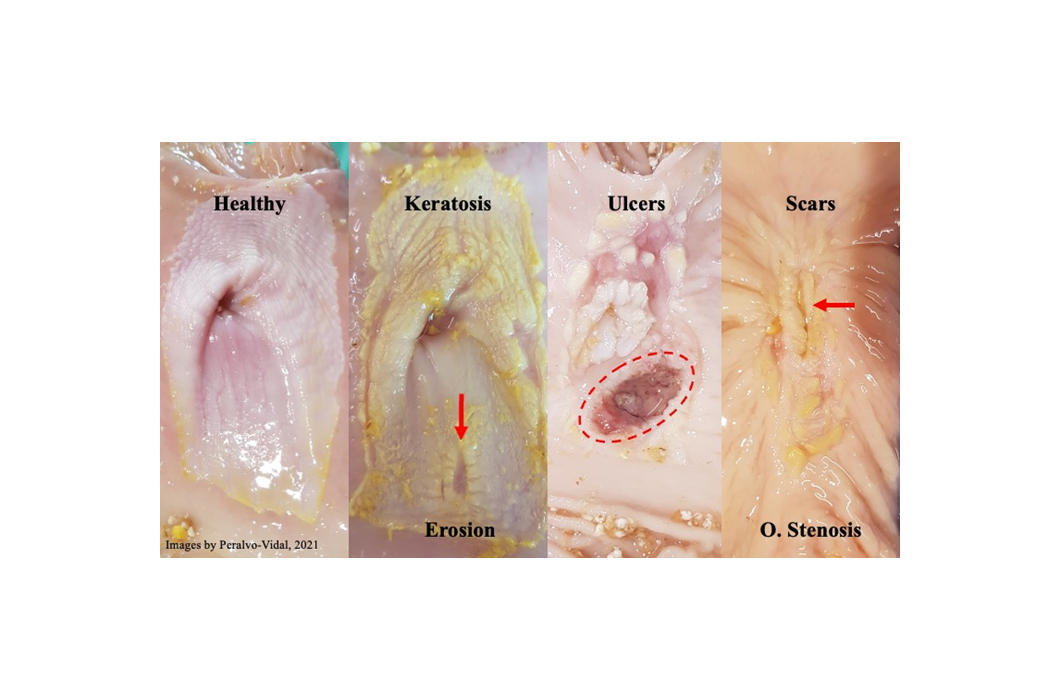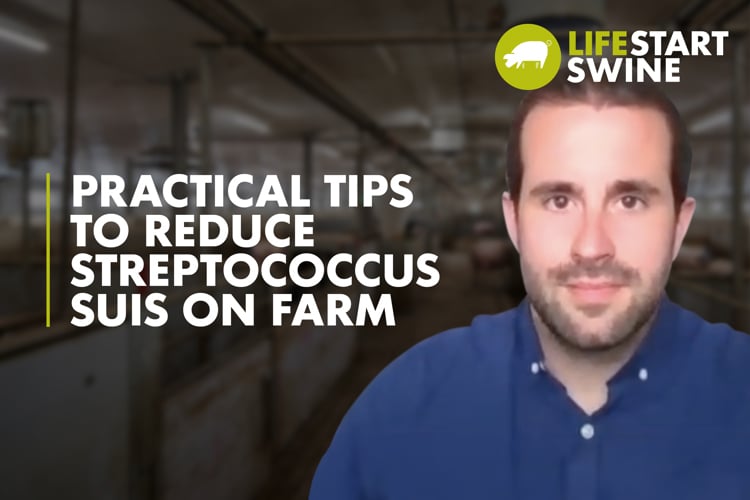
Dr. Juan Peralvo holds a DVM and PhD and currently works as a swine nutritionist with Trouw Nutrition. He’s worked in this role in the Latin American region for about a year and a half. Dr. Peralvo’s research is focused on pig gut health, specifically on gastric ulcers, and he's authored several peer-reviewed articles on the topic.

Gastric ulcers are typically thought of as a fattening or finishing pig problem, but research shows that they start developing much earlier. Sows and young pigs in all types of operations are highly susceptible to lesion damage.

How do gastric ulcers develop in pigs?
“To explain what gastric ulcers are, it’s important to understand how the stomach is anatomically positioned in the pig,” said Dr. Peralvo. “Gastric ulcers occur in the Pars Oesophagea (its Latin name), upper stomach area labeled 4, which is an area with a different kind of tissue (stratified squamous epithelium) than the rest of the stomach as it doesn't have the capability to secrete mucus. Thus, this area is not protected against the acidity and enzymes present in the gastric content.”
Whether on a farm or in the wild, pigs are exposed to different feeding patterns and feed resources that will allow them to form layers of pH in the stomach. The larger the feed particle size, the more consolidated this layering will be. On the bottom layer, the pH is lower and as you go to the upper layers of the stomach, the pH increases slightly. However, feeding pigs pelleted feed with a small particle size (< 500 um), the pH layering will be disrupted, and gastric ulcers will develop as the gastric content increases its fluidity. This increased gastric content fluidity will allow the hydrochloric acid and gastric enzymes secreted at the bottom to easily get in contact with the Pars Oesophagea, which in the long turn will stress the tissue and prompt the development of lesions and subsequently ulcers. However, is important to clarify that as the gastric content increases its fluidity, pH rises due to a buffer effect of the higher pH in the upper layers.
The four images above of the pars oesophagus show stages of gastric ulcer development:
Healthy – clean and white epithelium, shiny area
Keratosis – characterized by thickness (keratosis) and yellowish staining which corresponds to the hydrochloric secretion, bile acid reflux and enzymes present
Erosions - once keratosis is established and if the stress is maintained, lesions will arise. Erosions are considered when the lesion reaches the submucosa layer
Ulcers - if the gastric content doesn't change, over time, pigs’ erosions will turn into ulcers. This image shows a severe gastric ulcer (blood was cleaned away during the necropsy process)
Scars - if the feeding pattern/ feed particle size is changed and the problem is solved, the pig will still develop scars. The pars esophageal epithelium will be completely eroded and will disappear from the stomach, and the original esophageal sphincter opening size will be reduced resulting in a narrowing of the esophagus which makes it difficult for the pig to consume the feed.

Gastric ulcer’s impact on sow and piglet productivity
“In-farm studies have shown that about 5% of sudden deaths of production sows are related to gastric ulcers. This is because of how we feed sows in conventional production systems,” he explained. “We feed sows restrictively - either two times or one time per day. So, they go long hours with empty stomachs which means a higher exposure of hydrochloric secretion and enzymatic activity in the stomach which can lead to a higher risk of developing gastric ulcers, so it's definitely affecting the sow’s productivity.”
On finisher pigs, studies from Denmark have reported that there is a reduction in average daily gain on pigs affected with severe gastric ulcers, with losses reaching up to 200g that pigs cannot make up for later in the growth cycle. This loss is reported to be due to reduced feed consumption and changes in the feeding behavior or pigs affected with severe ulcers.
“There is also a perception among consumers that gastric ulcers are a problem for animal welfare,” he said. “As pork producers, we need to take gastric ulcers into consideration because our goal is not just to produce a high-quality meat but to produce this pork responsibly.”
What types of swine farms struggle with gastric ulcers?
“This is an important question because there is a serious misunderstanding that gastric ulcers are only a problem on conventional, modern farms,” he said. “The research has shown that sows and pigs from free-range farms and organic farms suffer from gastric ulcers as well.”
There are also reports that wild pigs roaming in Europe, the Americas and Africa also develop gastric ulcers because the stomach anatomy is the same. Gastric ulcers are not just based on the characteristic of the pig but on the feeding schedule of the sows and piglets. Since feed availability in wild pigs is not granted, long fasting periods are also associated with a higher risk for ulceration.
Is feed the main factor in producing gastric ulcers?
Gastric ulcers are multifactorial. Thus, several factors are associated with the development of gastric ulcers. Feed particle size is the leading one, however, not every pig fed with small particle size and sharing the same rearing environment will develop ulcers. Therefore, inherent pig factors might also play a role in this disease.
Dr. Peralvo’s PhD research project showed that small pigs – below 1.1 kilograms – have a 2.1 times higher risk of developing gastric ulcers.
“This occurs because those pigs are usually low in the piglet hierarchy and are more susceptible due to overall weakness, partly because they don't consume feed immediately,” he said. “Thus, they have a prolonged time of starvation and are more prone to develop gastric juices.”
Another important factor to consider for the development of gastric ulcers typically is prolonged feed withdrawal due to a break in the automatic feeder system. If a pig’s stomach is empty for more than 12 hours, it can easily begin to develop gastric ulcers.
When are swine gastric ulcers usually assessed/diagnosed?
Typically, it is the veterinarian at the slaughterhouse who reports back to a farm that a group of pigs has gastric ulcers. However, Dr. Peralvo’s research shows that ulcer lesions can be found much earlier – at 10 weeks of age (about 70 days of age).
“My research showed that pigs develop lesions early on, and the prevalence we observed was about 35% of pigs with some level of lesion in the stomach at 70 days of age,” he said. “This is one of the first research studies available showing that gastric ulcers are not just a problem in finisher pigs, but it's also in nursery pigs. This finding is important because if we are able to identify when the problem arises, we can determine the best strategy to solve the issues and reduce the findings observed in the slaughterhouse.”
He also noted that his research project spanned over three years, and that his data collected each year of pigs at 70 days of age was different. The first year it was 35% (as noted above); the second was 12%; the third year was about 45% within the same commercial farm.
“It's important to see that gastric ulcers are not a fixed problem, rather it's a problem that goes up and down,” he explained. “It's also related to the management of the farms. In Europe and North America, there are a lot of automatic feeders on the farm. Over the weekends, there may be no employees on the farm, and sometimes the automatic system is not functioning properly. When the farmers or the employees arrive back on the farm, they find out that for 12 hours or more none of the pigs were receiving feed because the system was blocked. That is the reason in some cases that they are seeing gastric ulcers develop.”
Preventing gastric ulcers
“As a nutritionist, every day I’m looking at ways to prevent the development of gastric ulcers,” he said. “I mentioned before that one of the ways gastric ulcers develop is due to the small particle size of feed. Yet it is important to point out that there is a productive and environmental reason why we reduce the particle size. When we reduce the particle size of the feed, we increase the surface area of the feed, in which enzymes are able to interact and extract more nutrients from the feed. Thus, reducing nutrient excretion (nitrogen and minerals) into the environment. On the contrary, if we have a large particle size, it will reduce the digestibility of the feed. As nutritionists, we are always trying to find the right level of particle size to increase productivity but also to reduce the risk of developing gastric ulcers. We are currently working to solve this challenge.”
What farmers and on-farm staff can do:
1. Monitor your sows and pigs constantly. If mortality increases, it's important to not only look at the typical reasons, like gut and lungs, but use necropsy to get more information, like gastric and stomach health, and report this back to your team and veterinarian.
2. Train your team. Given the multifactorial nature of gastric ulceration, long periods without feed for sows or finisher pigs, during times of stress for younger pigs, or changes in the feed particle size/structure. Train your team to highlight these issues or even things that are out of the normal as soon as they see them so managers can make changes or modify the current processes if they aren’t working.
3. Communicate with the feed mill. If a gastric ulcer problem exists, it's important to communicate this to the feed mill. If it’s happening on your farm, it’s likely happening on other farms too. Sharing your experience only helps to solve the problem faster and possibly helps other farmers and animals served by the feed mill.



